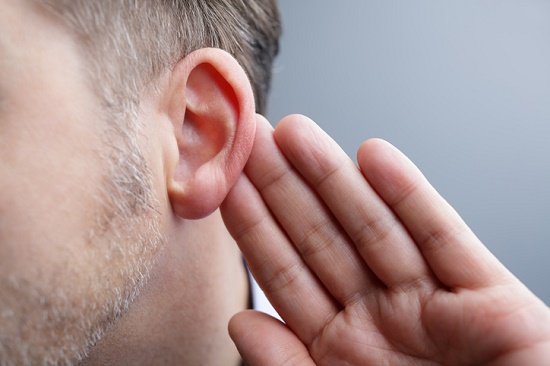
Your chances of developing hearing loss at some point in your life are regretfully quite high, even more so as you get older. In the US, 48 million people report some amount of hearing loss, including just about two-thirds of adults age 70 and older.
That’s the reason it’s vital to understand hearing loss, so that you can identify the symptoms and take preventative actions to prevent injury to your hearing. In this blog post, we’re going to focus on the most common form of hearing loss: sensorineural hearing loss.
The three types of hearing loss
Generally speaking, there are three types of hearing loss:
- Conductive hearing loss
- Sensorineural hearing loss
- Mixed hearing loss (a combination of sensorineural and conductive)
Conductive hearing loss is less common and is caused by some kind of blockage in the outer or middle ear. Common causes of conductive hearing loss include ear infections, perforated eardrums, benign tumors, impacted earwax, and hereditary malformations of the ear.
However, sensorineural hearing loss is far more common.
Sensorineural hearing loss
This form of hearing loss is the most common and accounts for about 90 percent of all reported hearing loss. It is triggered by damage to the hair cells (the nerves of hearing) of the inner ear or to the nerves running from the inner ear to the brain.
With sensorineural hearing loss, sound waves enter the external ear, strike the eardrum, and arrive at the inner ear (the cochlea and hair cells) as normal. However, as a consequence of damage to the hair cells (the tiny nerve cells of hearing), the sound signal that is transferred to the brain for processing is diminished.
This weakened signal is perceived as faint or muffled and usually impacts speech more than other types of lower-pitched sounds. Also, unlike conductive hearing loss, sensorineural hearing loss is usually permanent and cannot be corrected with medication or surgery.
Causes and symptoms
Sensorineural hearing loss has varied possible causes, including:
- Genetic disorders
- Family history of hearing loss
- Meniere’s Disease or other disorders
- Head injuries
- Benign tumors
- Direct exposure to loud noise
- The aging process (presbycusis)
The last two, direct exposure to loud noise and aging, account for the most common causes of sensorineural hearing loss, which is actually great news because it means that most cases of hearing loss can be prevented (you can’t avoid aging, obviously, but you can regulate the cumulative exposure to sound over your lifetime).
To fully understand the symptoms of sensorineural hearing loss, you should keep in mind that injury to the nerve cells of hearing usually unfolds very slowly. Consequently, the symptoms advance so slowly and gradually that it can be near impossible to perceive.
A small measure of hearing loss every year will not be very perceptible to you, but after a number of years it will be very noticeable to your family and friends. So although you may think that everyone is mumbling, it could very well be that your hearing loss is catching up to you.
Here are a few of the symptoms to look for:
- Difficulty understanding speech
- Problems following conversions, particularly with more than one person
- Turning up the television and radio volume to excess levels
- Regularly asking other people to repeat themselves
- Perceiving muffled sounds or ringing in the ears
- Becoming exceedingly tired at the end of the day
If you recognize any of these symptoms, or have had people inform you that you may have hearing loss, it’s a good idea to book a hearing test. Hearing tests are fast and painless, and the sooner you treat hearing loss the more hearing you’ll be able to conserve.
Prevention and treatment
Sensorineural hearing loss is mostly preventable, which is great news since it is without question the most common form of hearing loss. Millions of cases of hearing loss in the US could be averted by implementing some simple precautionary measures.
Any sound higher than 80 decibels (the volume of city traffic inside your car) can potentially affect your hearing with extended exposure.
As the decibel level increases, the amount of time of safe exposure decreases. Which means at 100 decibels (the volume of a rock concert), any exposure over 15 minutes could harm your hearing.
Here are some tips on how you can protect against hearing loss:
- Apply the 60/60 rule – when listening to a mp3 player through headphones, listen for no more than 60 minutes at no more than 60 percent of the max volume. Additionally, consider buying noise-canceling headphones, as these will require lower volumes.
- Protect your ears at live shows – rock concerts can vary from 100-120 decibels, far above the ceiling of safe volume (you could damage your hearing within 15 minutes). Limit the volume with the use of foam earplugs or with musician’s plugs that preserve the quality of the music.
- Protect your ears at work – if you work in a high-volume profession, talk with your employer about its hearing protection program.
- Protect your hearing at home – Several household and recreational activities produce high-decibel sounds, including power saws, motorcycles, and firework displays. Always use ear protection during extended exposure.
If you currently have hearing loss, all is not lost. Hearing aids, while not able to completely restore your hearing, can dramatically improve your life. Hearing aids can enhance your conversations and relationships and can protect against any additional consequences of hearing loss.
If you think that you may have sensorineural hearing loss, schedule your quick and simple hearing test today!
